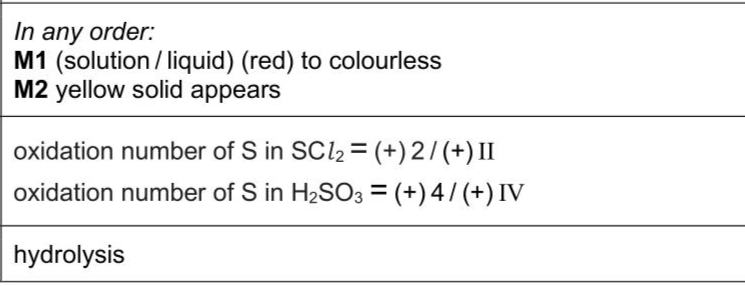$$\(\mathrm{SCl}_{2}\)$$ is a red liquid that reacts with water. $$\[ 2 \mathrm{SCl}_{2}(\mathrm{I})+3 \mathrm{H}_{2} \mathrm{O}(\mathrm{I}) \rightarrow \mathrm{H}_{2} \mathrm{SO}_{3}(\mathrm{aq})+\mathrm{S}(\mathrm{~s})+4 \mathrm{HCl}(\mathrm{aq}) \]$$ (i) Describe two observations, other than temperature change, that are made when an excess of water is added to $$\(\mathrm{SCl}_{2}\)$$. . (ii) When $$\(\mathrm{SCl}_{2}\)$$ reacts with water, the $$\(\mathrm{SCl}_{2}\)$$ is broken down and a disproportionation reaction occurs. State the oxidation numbers of sulfur in $$\(\mathrm{SCl}_{2}\)$$ and $$\(\mathrm{H}_{2} \mathrm{SO}_{3}\)$$. oxidation number of S in $$\(\mathrm{SCl}_{2}\)$$ oxidation number of S in $$\(\mathrm{H}_{2} \mathrm{SO}_{3}\)$$ (iii) State the general name to describe the type of reaction that occurs when a substance is broken down by water.
Exam No:9701_s25_qp_24 Year:2025 Question No:2(b)
Answer:

Knowledge points:
12.1.1 explain the lack of reactivity of nitrogen, with reference to triple bond strength and lack of polarity
12.1.2.1 the basicity of ammonia, using the Brønsted–Lowry theory
12.1.2.2 the structure of the ammonium ion and its formation by an acid–base reaction
12.1.2.3 the displacement of ammonia from ammonium salts by an acid–base reaction
12.1.3 state and explain the natural and man-made occurrences of oxides of nitrogen and their catalytic removal from the exhaust gases of internal combustion engines
12.1.4 understand that atmospheric oxides of nitrogen (NO) can react with unburned hydrocarbons to form peroxyacetyl nitrate, PAN, which is a component of photochemical smog
12.1.5 describe the role of NO in the formation of acid rain both directly and in their catalytic role in the oxidation of atmospheric sulfur dioxide
13.2.1.1 homologous series
13.2.1.2 saturated and unsaturated
13.2.1.3 homolytic and heterolytic fission
13.2.1.4 free radical, initiation, propagation, termination (the use of arrows to show movement of single electrons is not required)
13.2.1.5 nucleophile, electrophile, nucleophilic, electrophilic
13.2.1.6 addition, substitution, elimination, hydrolysis, condensation
13.2.1.7 oxidation and reduction (in equations for organic redox reactions, the symbol [O] can be used to represent one atom of oxygen from an oxidising agent and the symbol [H] one atom of hydrogen from a reducing agent)
13.2.2.1 free-radical substitution
13.2.2.2 electrophilic addition
13.2.2.3 nucleophilic substitution
13.2.2.4 nucleophilic addition (in organic reaction mechanisms, the use of curly arrows to represent movement of electron pairs is expected; the arrow should begin at a bond or a lone pair of electrons)
6.1.1 calculate oxidation numbers of elements in compounds and ions
6.1.2 use changes in oxidation numbers to help balance chemical equations
6.1.3 explain and use the terms redox, oxidation, reduction and disproportionation in terms of electron transfer and changes in oxidation number
6.1.4 explain and use the terms oxidising agent and reducing agent
6.1.5 use a Roman numeral to indicate the magnitude of the oxidation number of an element
Solution:
Download APP for more features
1. Tons of answers.
2. Smarter Al tools enhance your learning journey.
IOS
Download
Download
Android
Download
Download
Google Play
Download
Download
